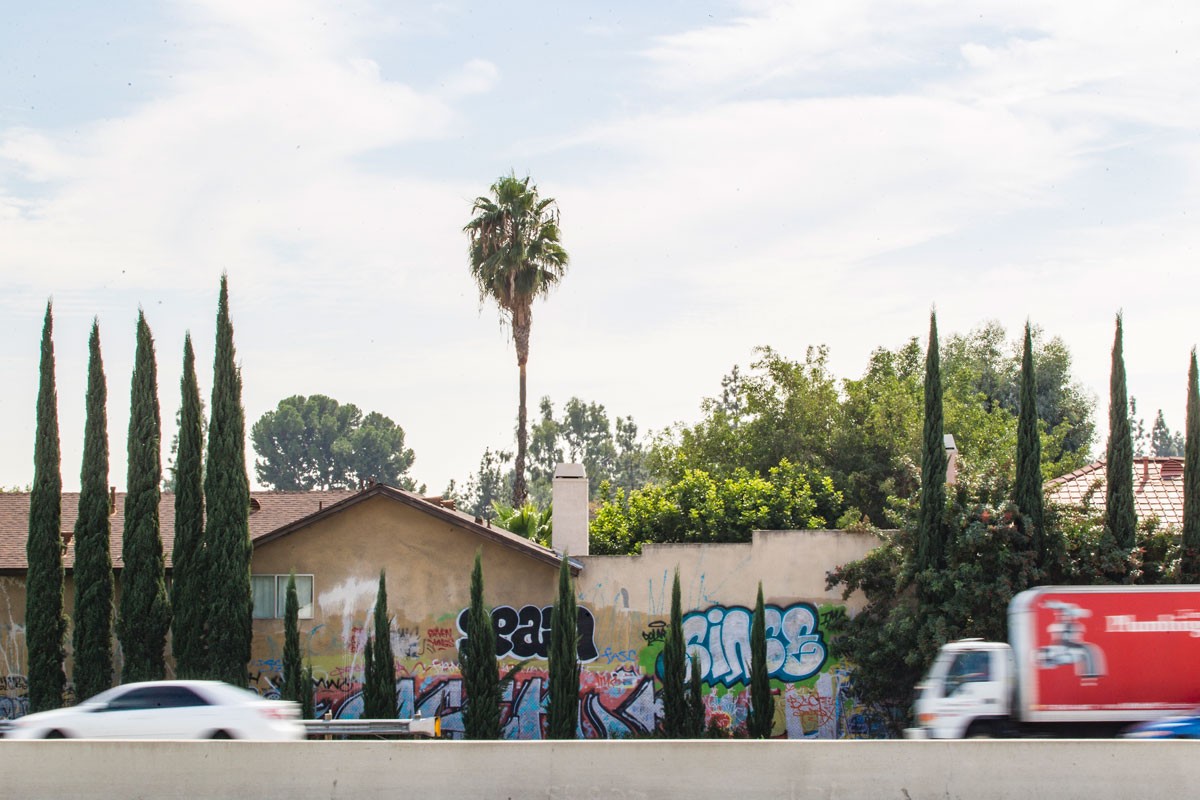
Note: The names of some graffiti writers have been changed.
In the dead of night, six spray-can-wielding teenagers waited at the base of a chain-link fence dividing the eastbound 22 freeway from townhomes near the City Drive exit in Orange. Cars zipped by just feet away from them, but the youngsters were too busy scheming to be scared. On the other side stood their prize: the city's Great Wall of Graffiti, a nearly 1,000-foot canvas of the backside of townhomes where nearly anyone can put up their names without fear of rivals or punishment by the law.
The six teens effortlessly scaled the fence, slowing down to give a little boost to the homie Dot, the heaviest of the squad. The youngest of the crew, just 15, sprinted down a pathway behind the townhomes and sprayed four throw-ups—bubble letters that make up his street name,
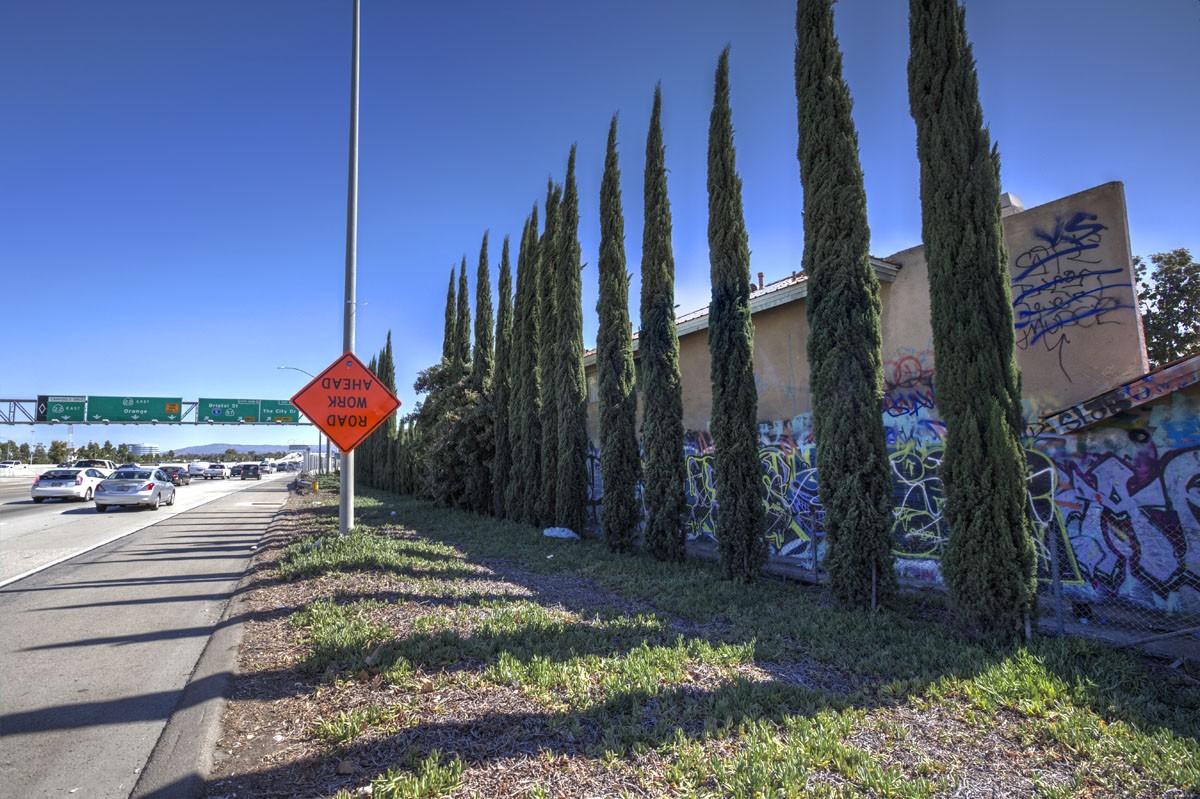
Suddenly, a siren wailed.
That was the last time
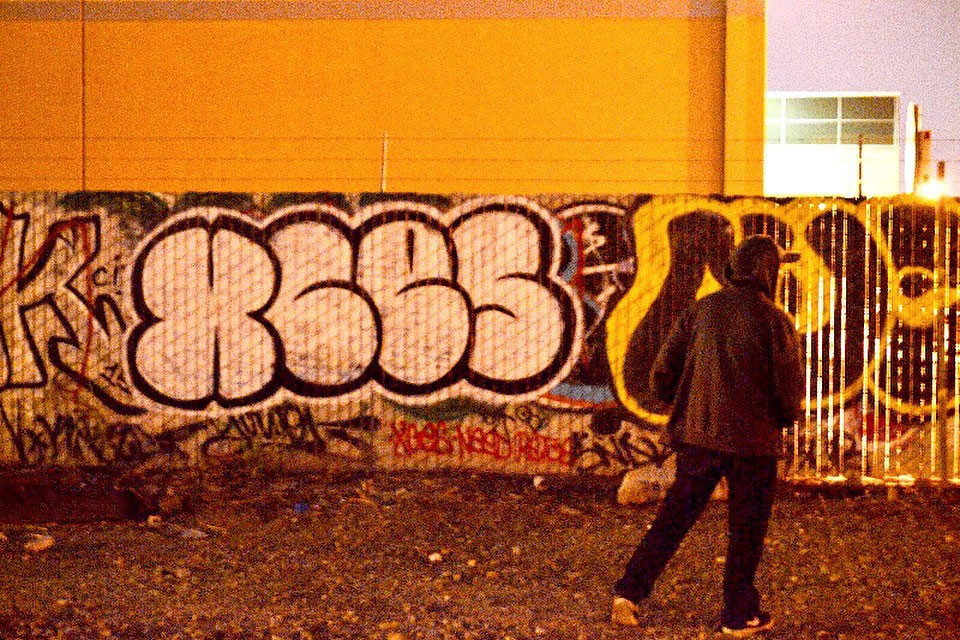
In a county notorious among graffiti writers for monotonous streets and quick clean-up response times, the Great Wall of Graffiti is a legend. Its size and prominence—seen by a quarter of a million people daily—is almost unmatched in Southern California. It's a Switzerland of sorts for OC's graffiti scene, where
For more than a decade, vets and rookies (“kings” and “toys,” in the scene's lingo), outsiders and locals have had free rein here, and no one has been able to stop it—not frustrated residents, not Caltrans, not a booming homeless population, not even Orange code enforcement or police officers.
“It's a safety issue, right?” asks Sherman Kyles, who grew up in a townhome whose back yard is an entrance to the graffiti wall. His mother has lived in that home for 36 years. “People don't know: You're scared; someone is in your back yard.”
* * * * *
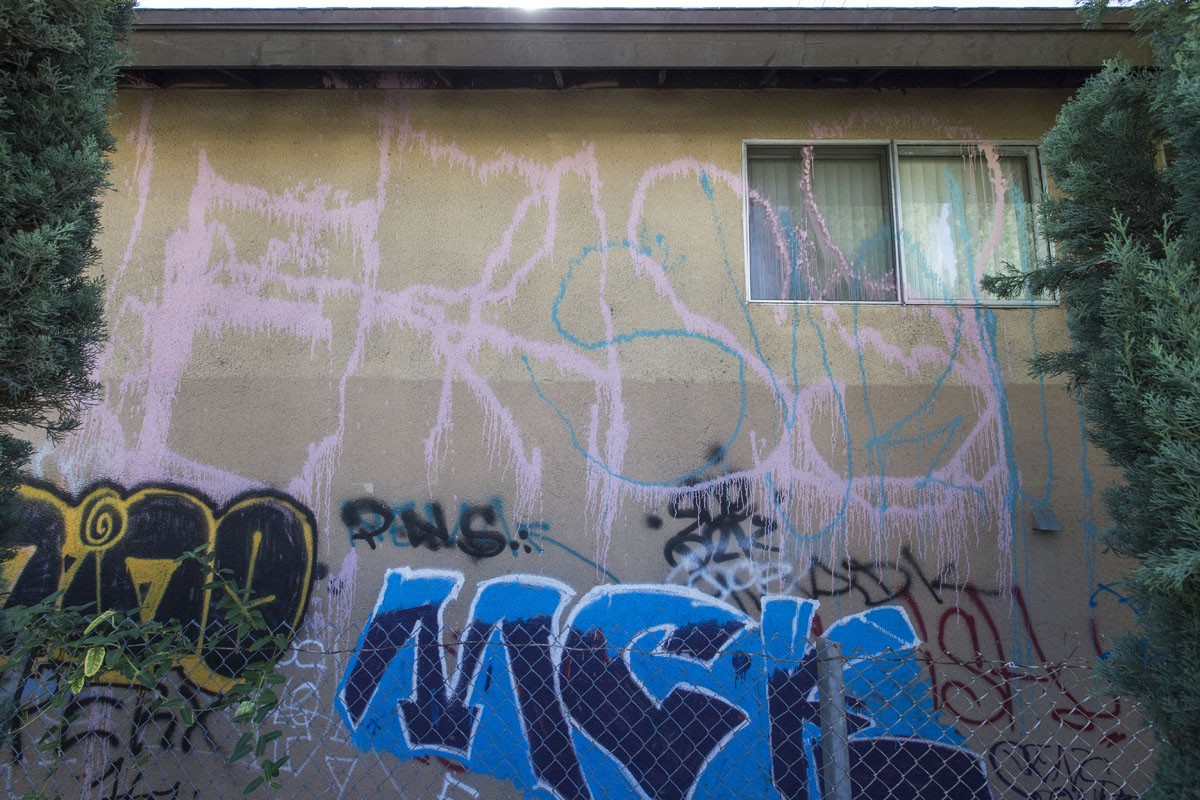
The Park City Homeowners Association—104 brown-and-beige units with 28 homes that flush against the Garden Grove Freeway—make up the foundation of the Great Wall of Graffiti. From their second-story windows, residents have an unfettered view of the Orange Crush, the Crystal Cathedral, the Outlets of Orange and the Cash Call skyscraper.
But that's not what motorists on the eastbound 22 see as they inch toward the 5 freeway: Alongside the graffiti are trash, broken glass and empty spray cans. Simplistic tags scattered across the wall blend in with larger, more complex, nearly muralistic pieces. Some stylish letters have cartoon caricatures embedded within them. Graffiti pieces layer over one another, creating a palimpsest that at times spills beyond the wall and onto homeowners' windows. A row of Italian cypress futilely try to mask the scene.
Park City inhabitants actually date the start of the tagging to the $550 million widening of the freeway that began in 2004 and ended in 2007. “Before they expanded the freeway . . . it was all huge eucalyptus;, it was awesome,” says Kyles. “Huge sound barrier; you couldn't hear anything. You could actually go on a little nature walk, if you felt like it. . . . The neighborhood itself wasn't as dilapidated.”
[
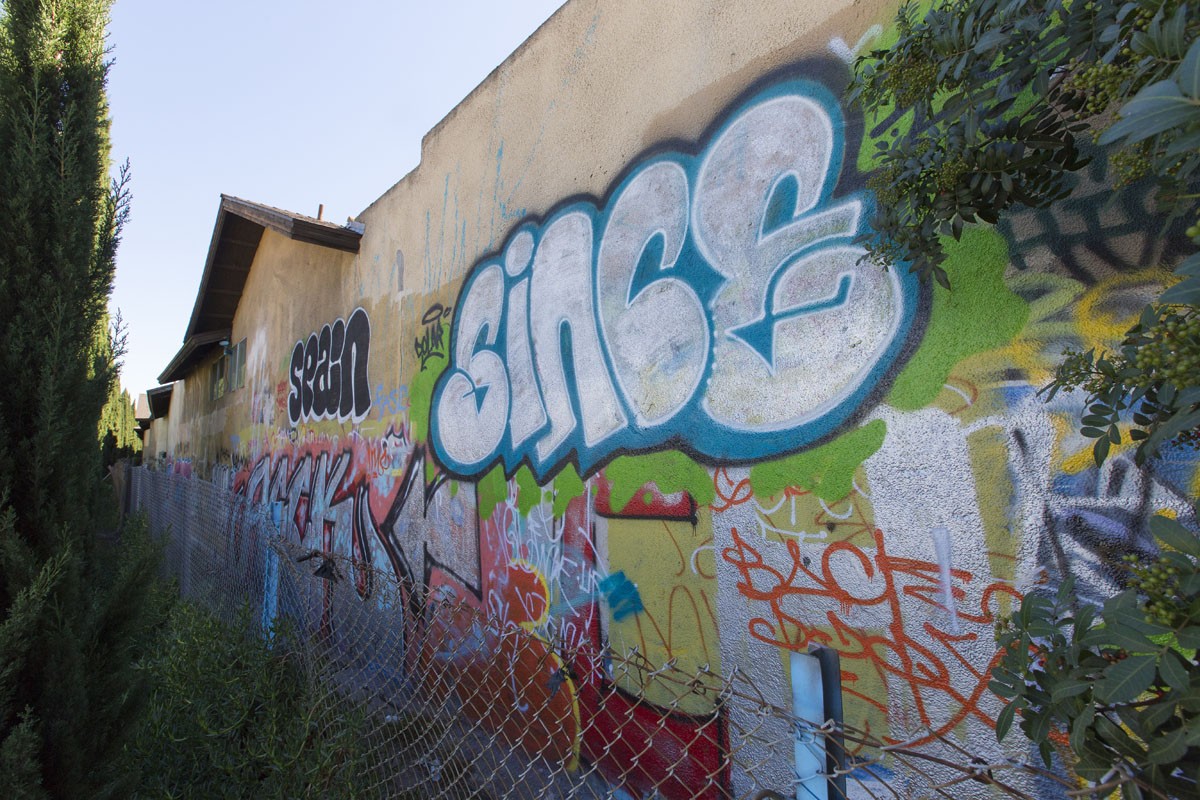
Through Measure M funds, Caltrans, Federal Highway Administration and the Orange County Transit Authority (OCTA) built a single mixed flow and a single carpool lane to each direction of the 22. “Think about it: Caltrans is actually responsible for the mess,” says Mario Sanchez, a 13-year homeowner of a Park City residence covered in graffiti. “Once Caltrans widened the freeway . . . they took down one fence, they took down the bush, they took down all the trees, and that exposed the wall. And that's how [graffiti writers] saw it, and that's why they go there: because it's visible from the freeway.”
A towering, husky man, Sanchez is the unofficial neighborhood watch of his block, sitting sentry from the comfort of his front lawn. The neighborhood kids endearingly call him Uncle Buck. “The [Santa Ana] riverbed is constantly getting cleaned up. Yet here, we have 'The Gallery,'” Sanchez says with a tone of frustration. “I just call it 'The Gallery' because everyone does their paintings there. It's no museum, that's for sure.”
A few homes down from Sanchez, a married couple, who asked to remain anonymous, share that their second-story bedroom window is covered with splatters of light-blue spray paint. “I haven't heard anyone at night,” the wife says. “It does upset me, but since I'm on this side, it's kind of out of sight, out of mind. But when I drive by, it's like, 'Wow, that's terrible.'”
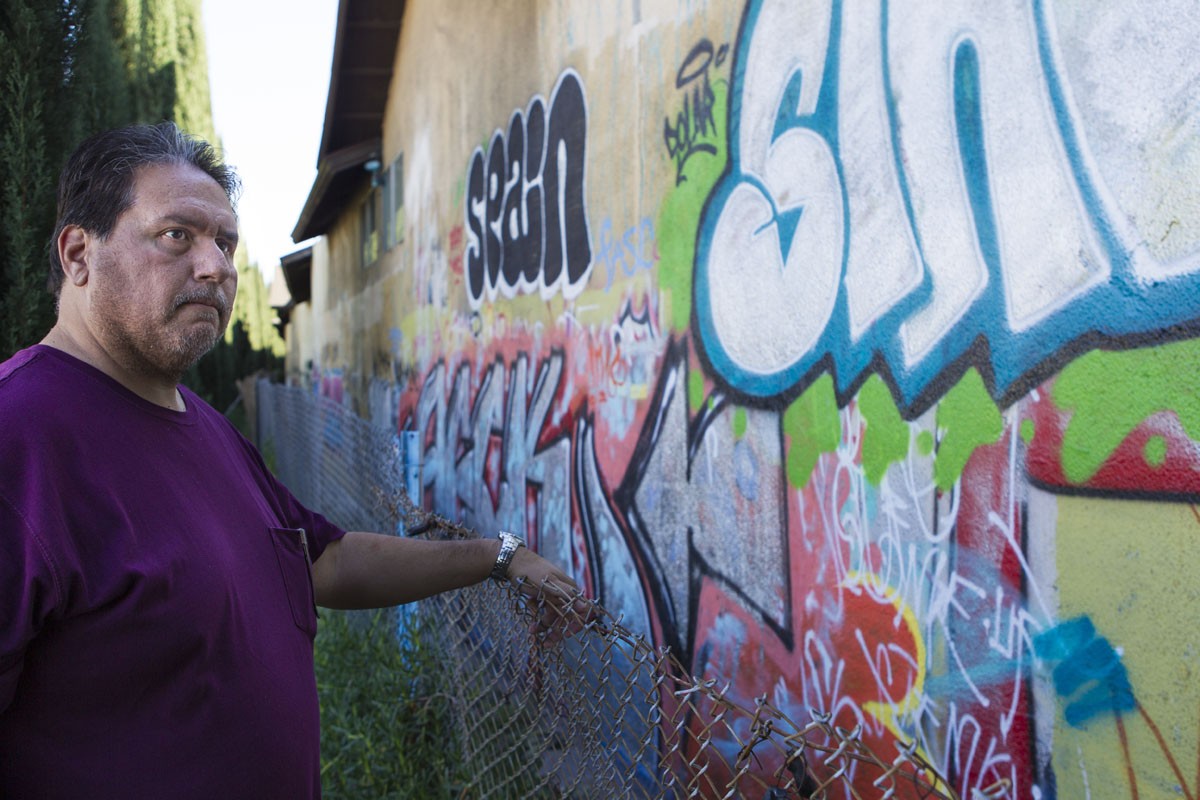
While some homeowners don't mind the graffiti because they don't necessarily have to face it every day, most hate it. “It makes the neighborhood look like a ghetto,” says Brian Drouillard, who has lived in the area for five years. His home isn't part of the graffiti wall, but it neighbors the targeted Park City abodes. “I see that . . . coming off the freeway, and to me, it's embarrassing being a resident of Orange. I was born and raised in Huntington Beach; it's unacceptable there and here—anywhere for that matter. I mean, this is Orange County, for goodness sake.”
Drouillard says his calls to the city of Orange to remove graffiti on property near his home get responded to quickly. But the wall on the Park City properties remains ignored. Sanchez says when he inquired about the city removing the graffiti on the backside of the townhomes, he was told the city doesn't remove graffiti on what's deemed private property unless it's within 10 feet of a public sidewalk—which the wall isn't.
“I'm not against the art form itself; I'm against the lack of respect,” says Kyles. “I wouldn't care if they came up and talked to me and said . . . 'Can I do some urban art?' Just ask me or ask my mom. . . . What bugs people is just the invasion of privacy. . . . That's all it is. If there was an area where people can graffiti, I'd be all for it.”
* * * * *
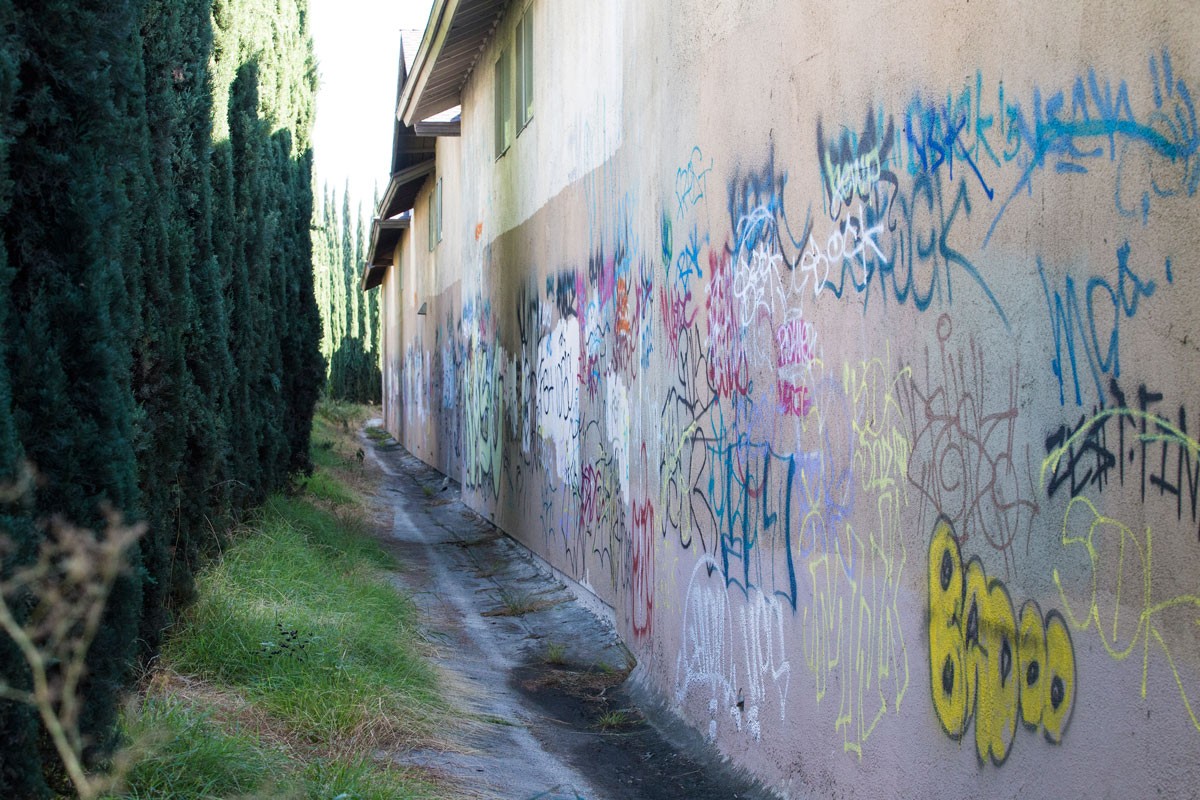
The artists who haunt the Great Wall don't take their luck for granted. They're glad that bureaucratic red tape leaves them alone. Who's actually responsible for maintaining the wall is a matter of dispute. OCTA and Caltrans confirmed that the 22 freeway is owned and operated by Caltrans; however, Caltrans' graffiti-removal hotline does not service private property. “It's one of those unique things because [the homeowners] are the victims, and they are responsible for removing it,” says Lieutenant Fred Lopez, public information officer for the Orange Police Department. “The owners have cleaned it, and it comes right back.”
Lopez says the city has estimated that each cleanup of the Park City wall costs $2,000. Residents of the community pay a $75 “quarterly assessment” fee to the Management Trust, the community management firm that represents the Park City Homeowners Association. According to Sanchez, this fee is supposed to cover maintenance costs for Park City homeowners. But, residents claim, they're expected to pay the additional expense to remove the graffiti on their property, while they feel they shouldn't have to because it should be either the city's responsibility or Caltrans', given how public the colorful chaos is. Two homeowners say they've left multiple voicemails for The Management Trust regarding the graffiti issue to no avail. Sanchez says he once received a call back nearly three weeks after leaving a voicemail—but he was told homeowners had to fix the problem themselves.
“[The homeowners association and The Management Trust] have washed their hands of it and put it on the 28 property owners,” Lopez says. “So, I ask you, how many thousands of dollars are you going to continue to throw at that problem?”
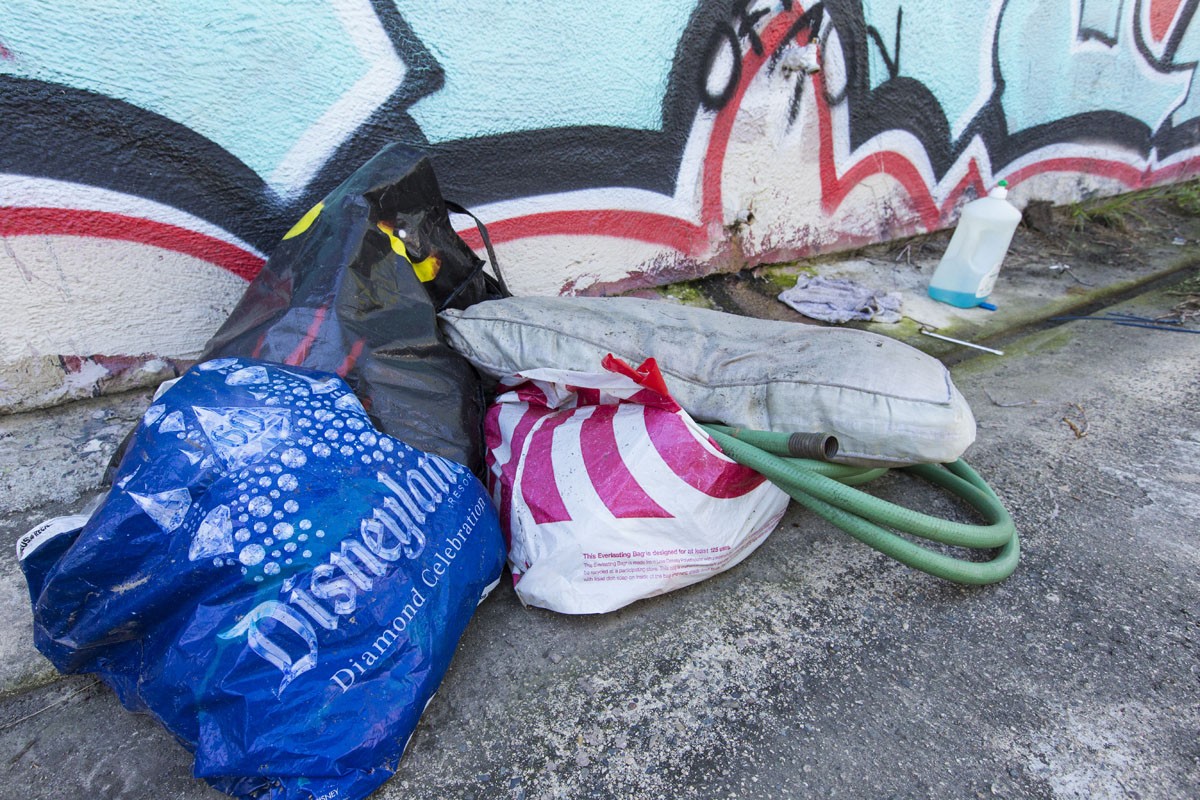
Sarah Deason, a representative for The Management Trust, says the matter was resolved in a meeting with the Park City HOA board members and representatives of the Orange mayor's office in 2012. According to Deason, notifications to residents were sent about their responsibility to maintain their own property walls after the decision was reached. When asked about how the quarterly assessment doesn't cover graffiti removal, Deason said the fee only covered “common areas,” such as landscaping and lighting.
[
Sanchez says he never received such a notice from the city and is upset that other Orange residents are offered the city's graffiti-removal services despite being private homes. “That's not right,” he says. “Do I have to remove the homeless camp, too?”
Manny, a groundskeeper for a Park City homeowner, has his own way of combating the graffiti. “I painted it,” he said, “and then I put Thompson's WaterSeal, so when [the taggers] would come back with their cans, [the paint] would run.”
Graffiti isn't the only issue the Great Wall is causing for Park City residents. Down the narrow pathway that runs along the backside of some of the Park City properties —the same pathway used by taggers—are the remnants of a former homeless camp. Strips of cardboard and plastic tarp create a makeshift homestand against the chain-link fence that separates the freeway and the townhomes. Parts of the fence have gaping holes that appear to have been cut out with gardening shears, and someone's bicycle is tied with a U-lock to the fence. A short detachable hose is attached to a water faucet peeking out from a townhome's back wall. By this makeshift shower, a large bottle of dish soap sits next to a pile of dirty rags.
But that's not what upsets Sanchez the most. Piles of human feces topped with squares of toilet paper are a few feet away from the encampment, underneath townhome windows. And dozens of cigarette butts litter the grounds. Sanchez calls the site “a serious fire hazard. . . . If this doesn't get fixed quick, it's gonna be just like the riverbed.”
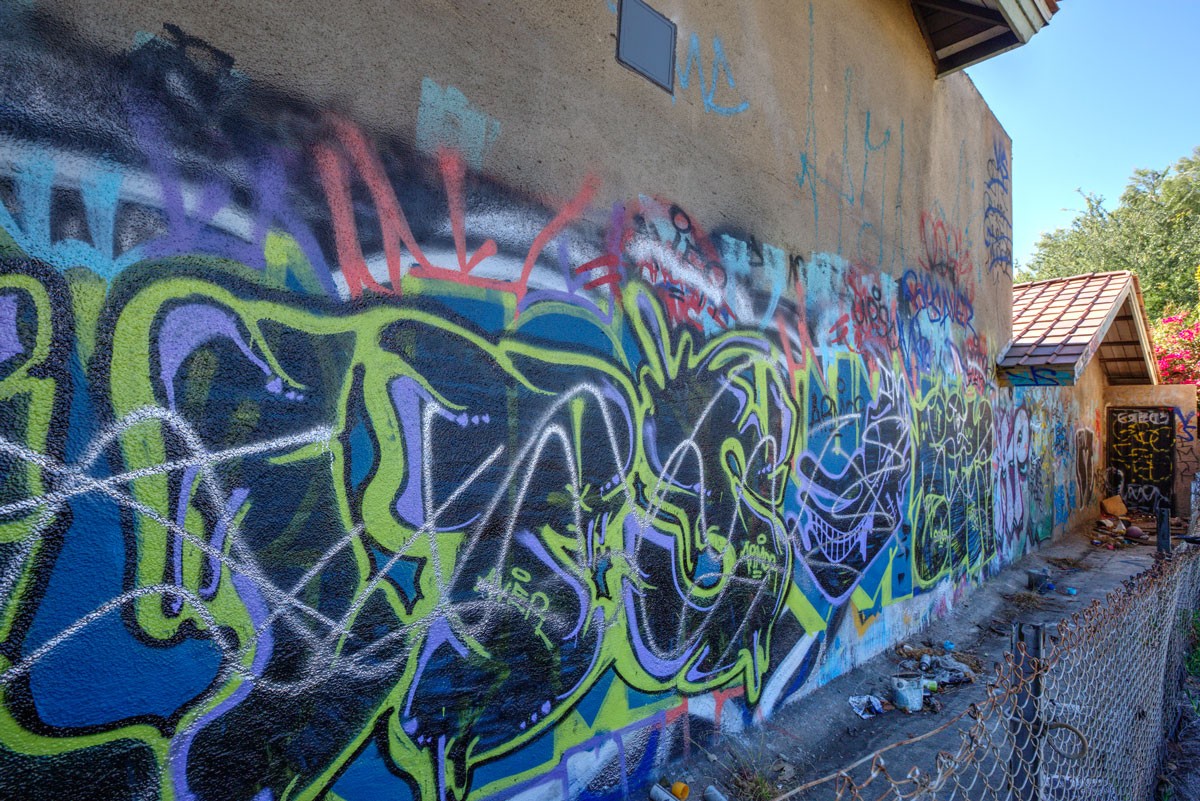
“I notice homeless come through [the sidewalk in front of his house] and dig through this trashcan here,” says Drouillard, “This place is a goldmine; it's packed every single night [with homeless people]. But I've never seen a homeless in the tract actually stay and set up camp.”
Even graffiti writers have noticed the uptick in homeless people. Since, an active local graffiti writer, recalls meeting a lone homeless man with an amputated arm during a late-night session on the Great Wall. “He told me a little about himself,” Since says. “He said Caltrans was giving him a hard time because he was living there.”
When Sanchez called the Orange Police Department about the encampment, it was gone within the week, he says, although the makeshift shower, cigarette butts, holes in the fence and graffiti are still there. “Any one of the owners, if they have a trespasser on their property, they can call us and ask for our assistance,” Lopez says. “All they have to do is sign a trespassing affidavit, and we can remove them from the property because [the wall and pathway around it] is private property.”
* * * * *
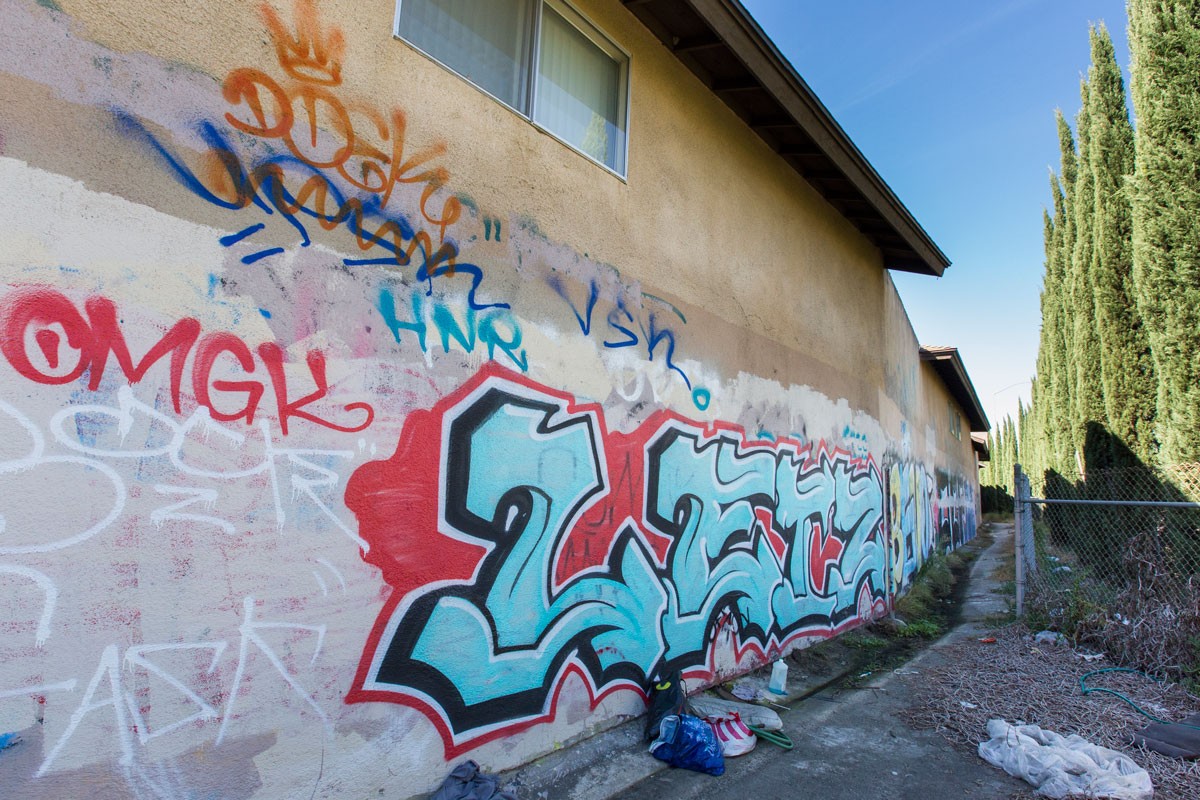
“I'm not a sinner or anything like that,” says Since, arguing his tagging isn't meant to deface anyone's home. He was once caught behind Park City by police officers who happened to be on patrol looking for gang members; he was let go with a verbal warning. “To me, personally, I don't find [graffiti] to be something for me to run from, as if I was doing something wrong.”
Since proposes
“I like the idea of the artists coming through and making it a work of art, as opposed to tagging,” Drouillard says. “There's a big difference between tagging and artwork. That's not artwork over there; that's tagging, plain and simple.”
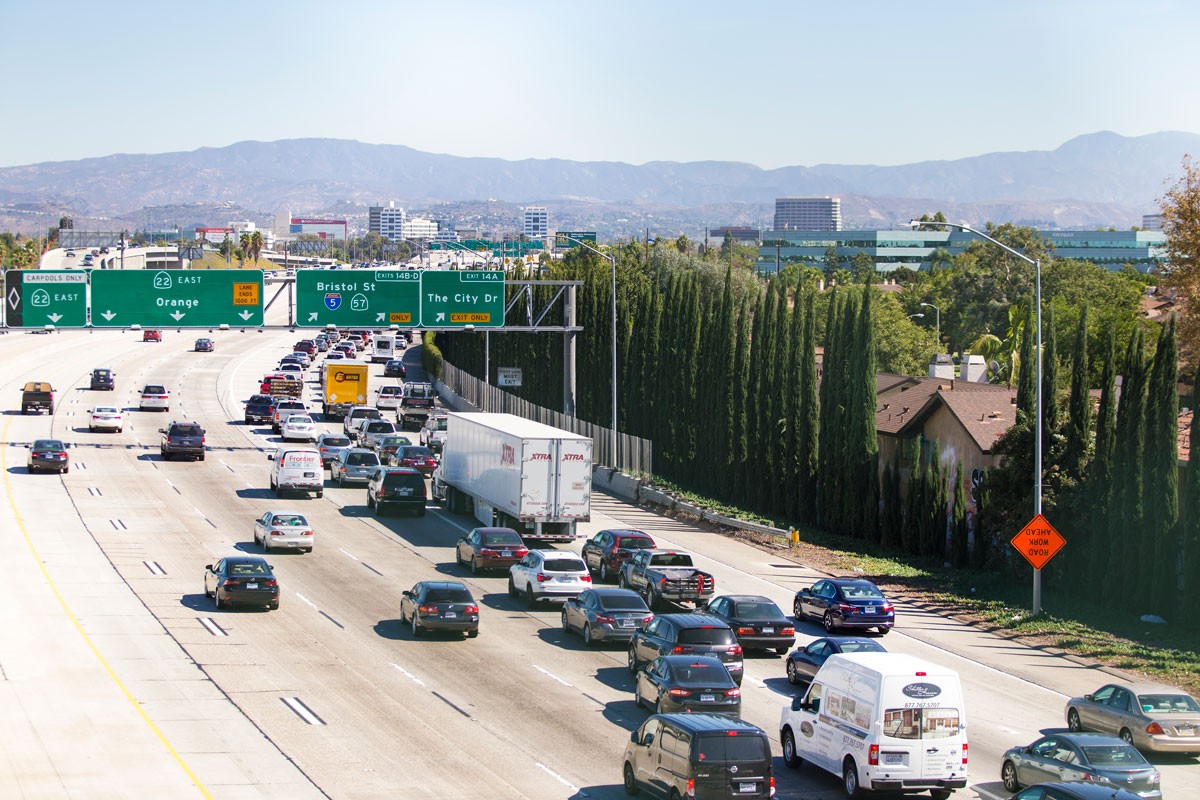
Sanchez and his neighbors, however, scoff at Since's offer. “It wouldn't last; they'll write over it,” says one resident. “They're disrespectful. They're taggers—that's their mission.”
Some graffiti artists are quick to distinguish themselves from “taggers.” “I skateboarded, I wrestled, I played baseball—I've done all those types of outlets. . . . I wasn't ever good enough, and I hated it,” says Xces. “Something about graffiti, when I caught a tag, nobody knew who I was physically, but something about when they heard my name and . . . paid me some respect—something about that filled the empty gap that I've had throughout my adolescence.”
[
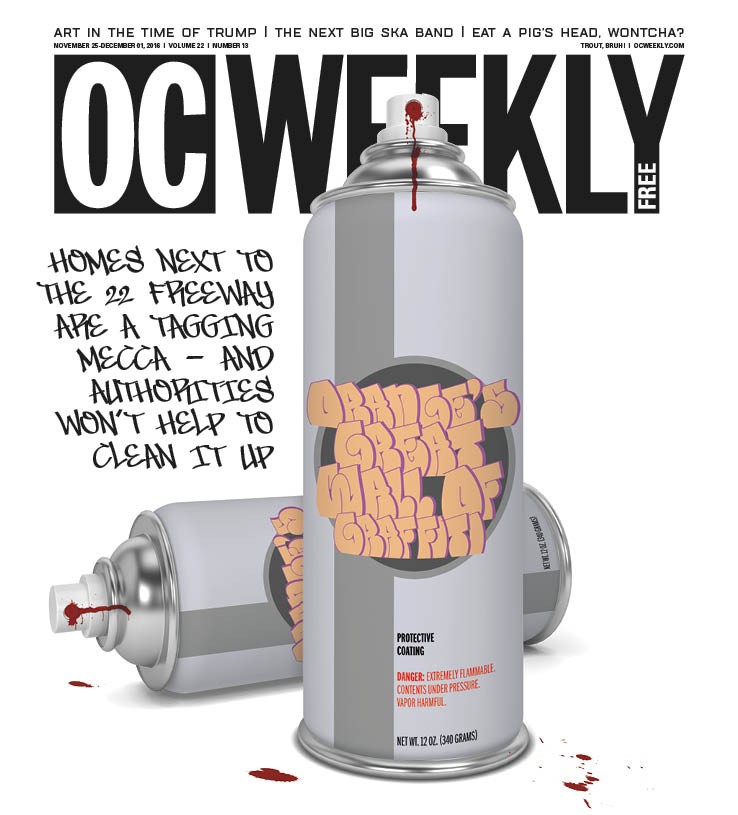
While the idea of an artistic mural sounded noble to Xces, he also agreed it seemed unrealistic. “Some of those guys that are on that freeway, they're probably battling or they just want to catch a spot,” he says. “If they put up that mural, it's going to get disrespected. But it's a great idea. I want more public art.”
Other solutions proposed by residents have included setting up cameras on the Great Wall, motion-sensor alarms, even watch dogs—but all those ideas would cost money. The most effective strategy is the Italian ivy growing on the backside of some townhomes; they boast noticeably less graffiti than the other walls. But, Sanchez, an expert gardener, says the ivy roots could damage property in the long run, as the roots get into the walls, causing cracks and, thus, leaks.
In the meanwhile, the graffiti continues. “There's graffiti in the [community] park . . . on the trees, on the light poles, on the rocks,” says Sanchez. “It's getting worse and worse and worse.”

